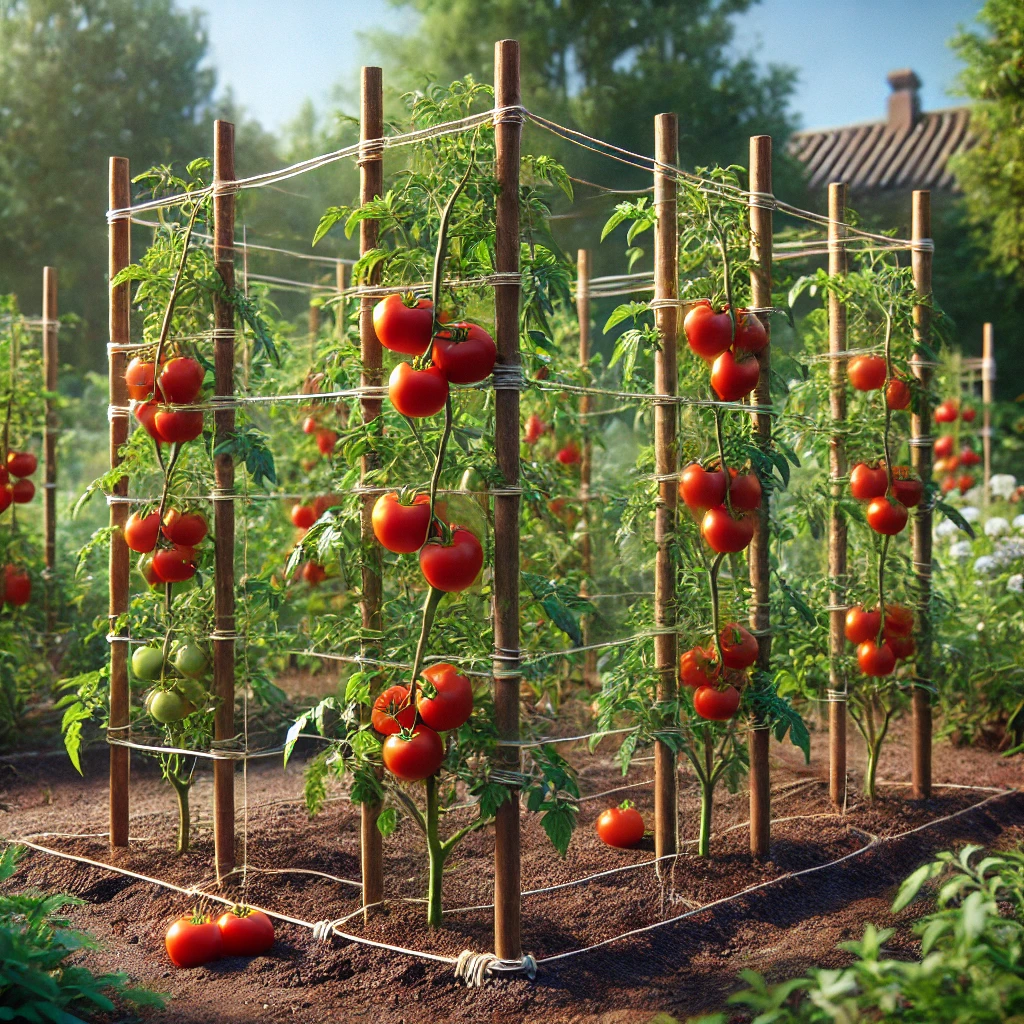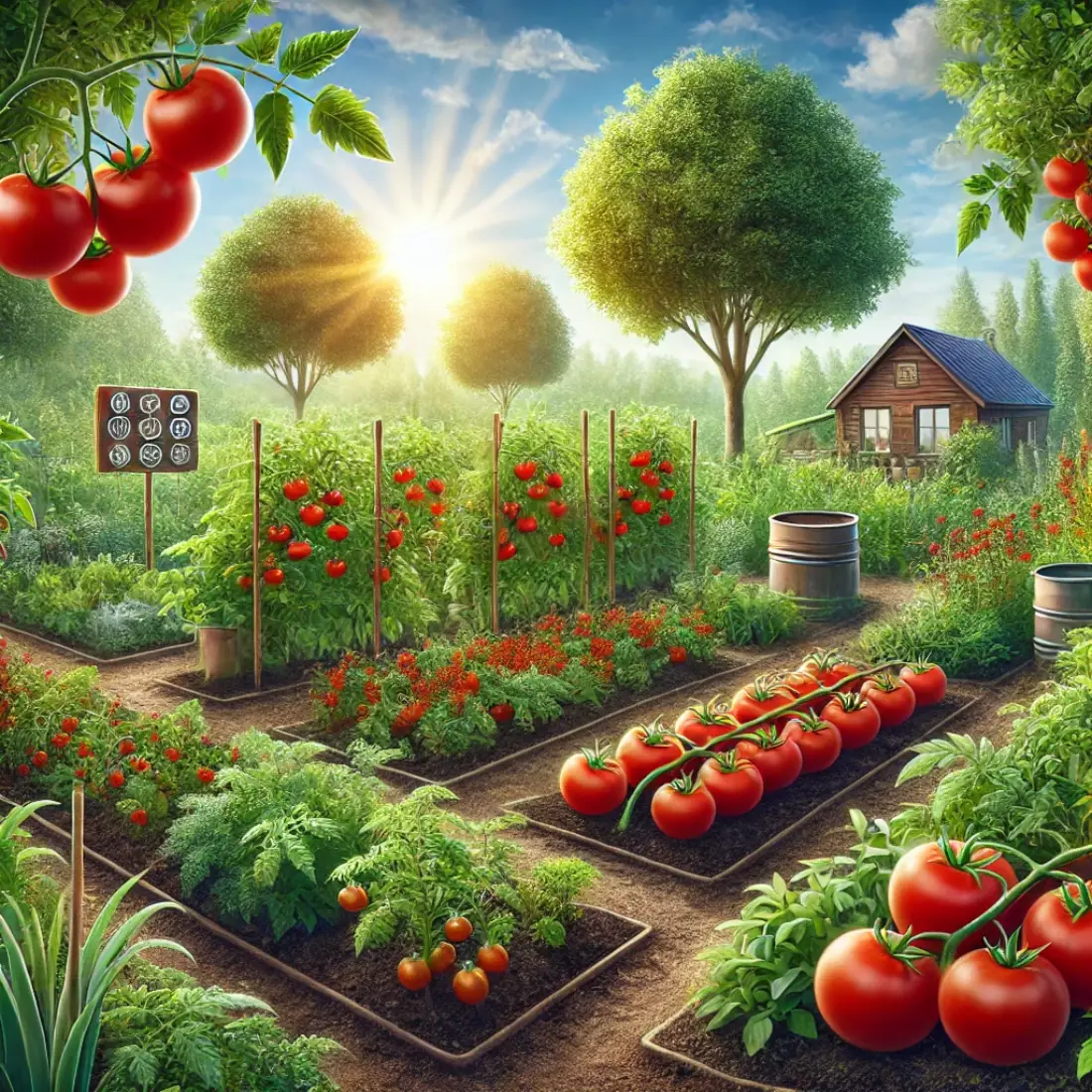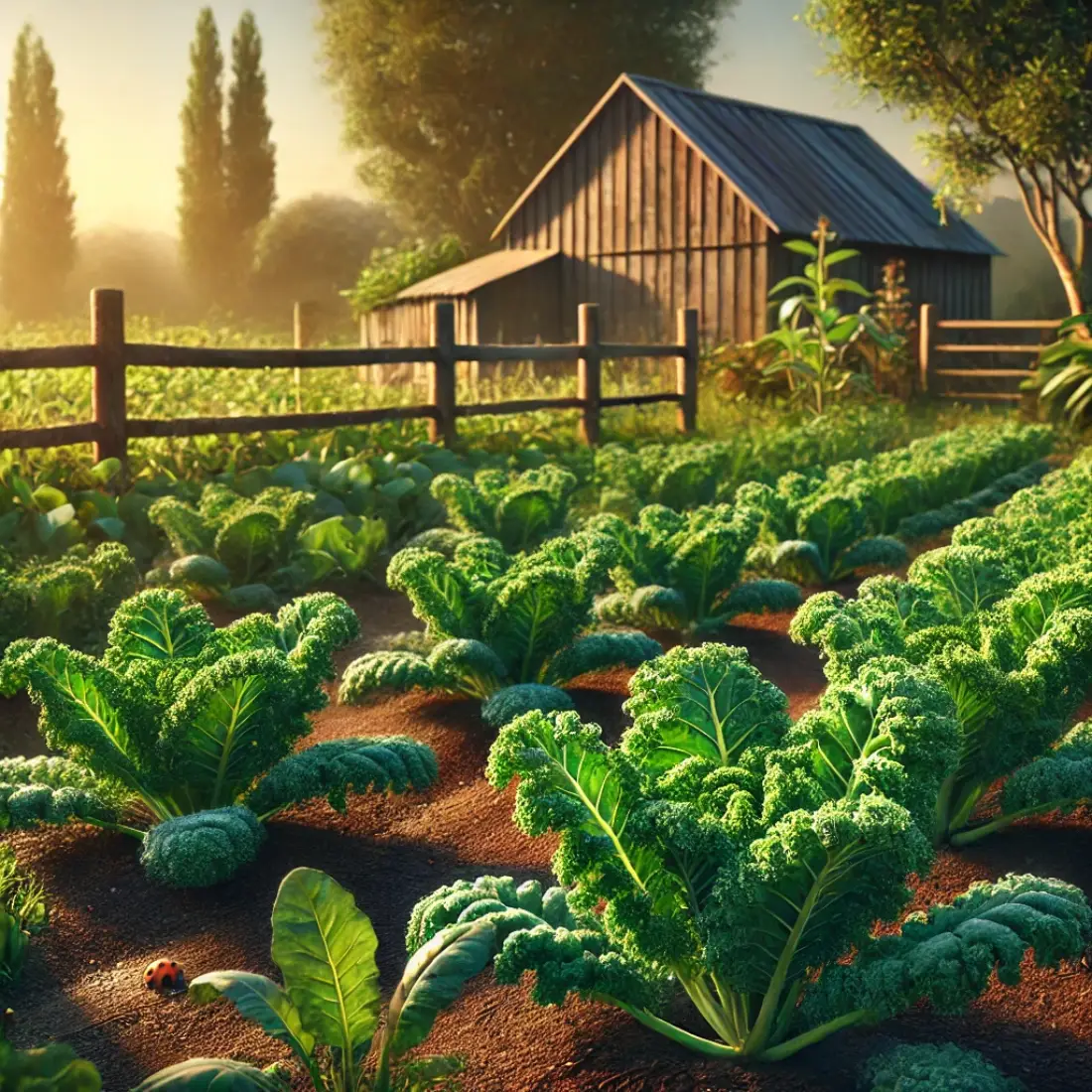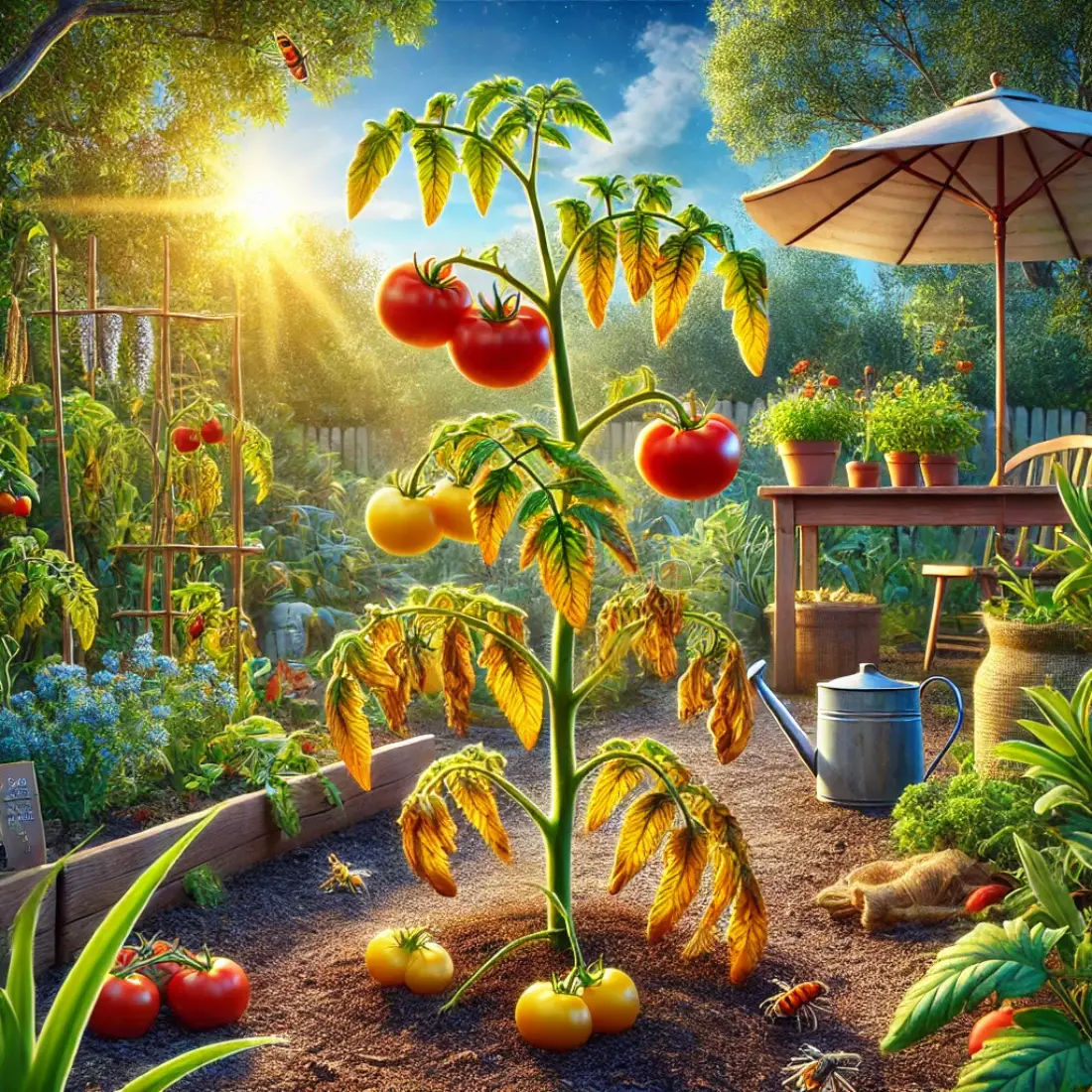Using a tomato trellis has numerous benefits. First, it enhances air circulation around the plants, reducing the likelihood of fungal infections. Second, it ensures better exposure to sunlight, leading to more robust photosynthesis and ultimately, higher yields. Moreover, trellises make harvesting easier, as tomatoes are more accessible and visible, reducing the risk of damage during picking.
There are various types of trellises available, from simple stakes to more complex cages and panels, each catering to different tomato varieties and garden sizes. While purchasing a ready-made trellis is convenient, building your own can be more cost-effective and tailored to your garden’s specific needs.
- Tomato trellises support the healthy growth of your plants.
- There are various types of trellises to choose from.
- Building your own trellis can be cost-effective and customizable.
- Proper maintenance of your trellis is crucial for longevity.
Types of Tomato Trellises
Choosing the right tomato trellis is crucial for supporting the growth and health of your plants. There are several types of trellises, each with its unique benefits and ideal use cases.
Stake Trellis
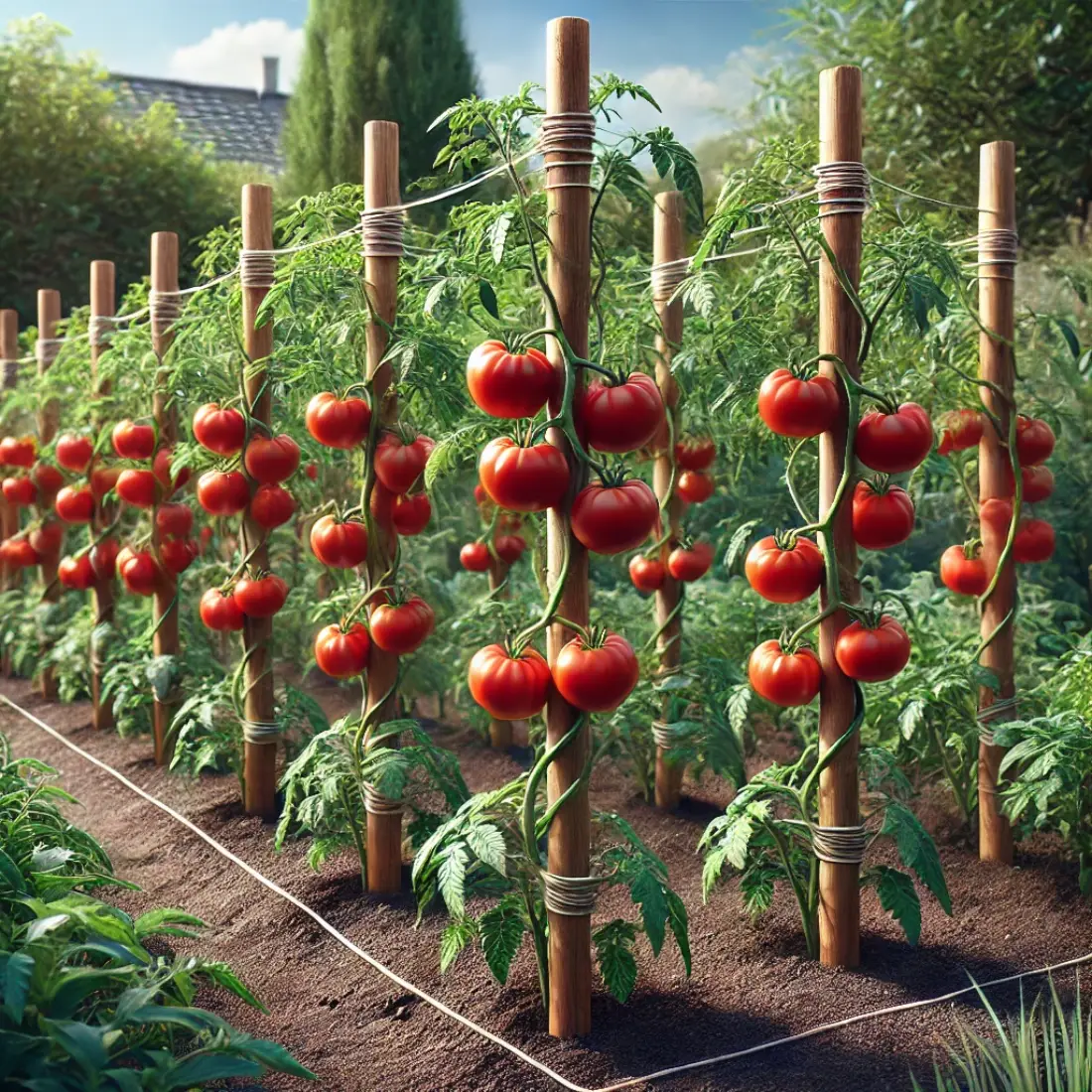
A stake trellis is one of the simplest and most effective methods for supporting tomato plants, especially in smaller gardens. It involves driving a sturdy wooden or metal stake into the ground next to each tomato plant and tying the plant to the stake as it grows. This method is cost-effective and easy to set up but requires regular maintenance to ensure the plants are securely tied and the stakes remain upright.
Cage Trellis
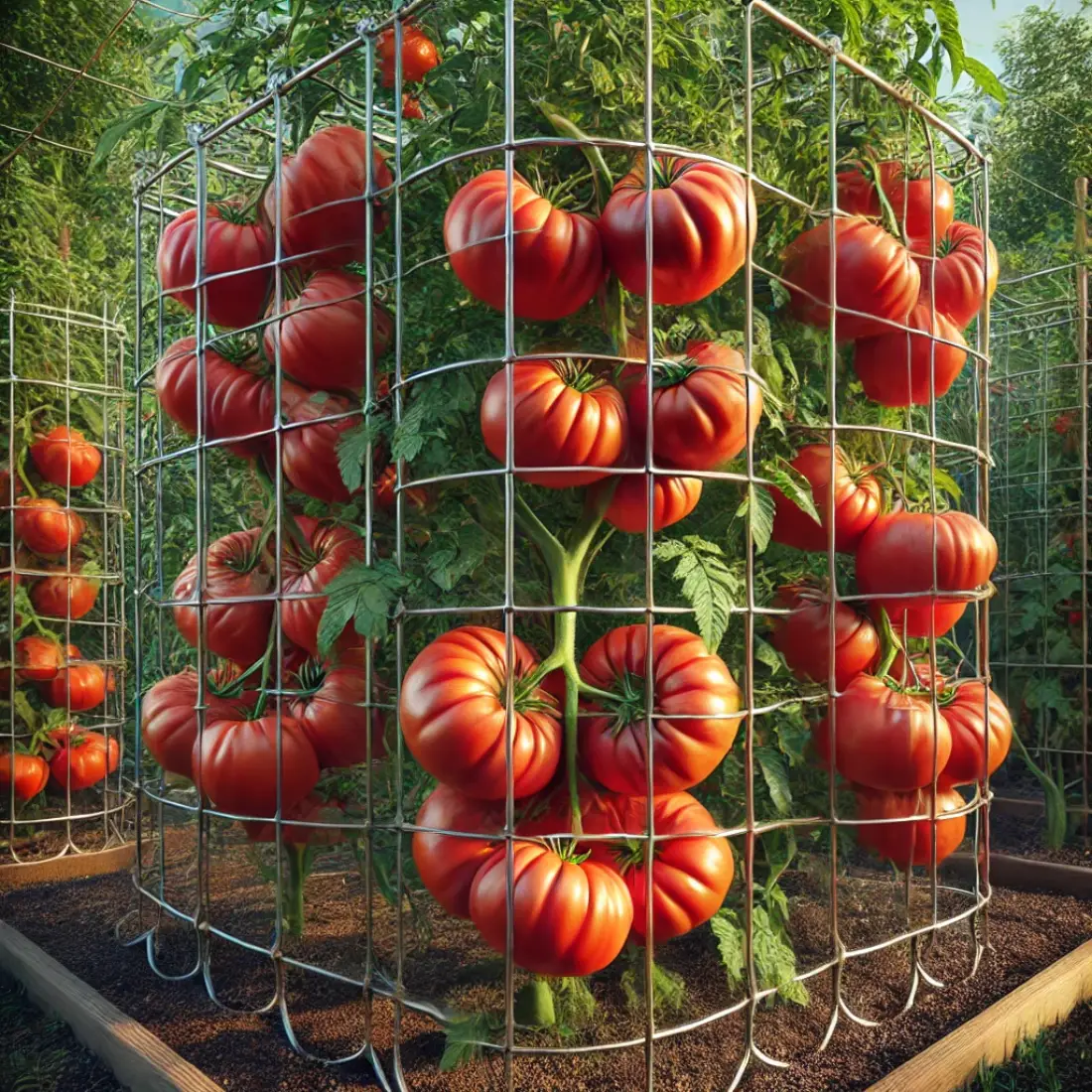
The cage trellis is a popular choice for larger tomato varieties. Typically made from metal or heavy-duty plastic, these cages surround the plant and provide support on all sides. They allow the plant to grow naturally while offering excellent support for heavy fruit. Cage trellises are durable and reusable, making them a great long-term investment.
String Trellis
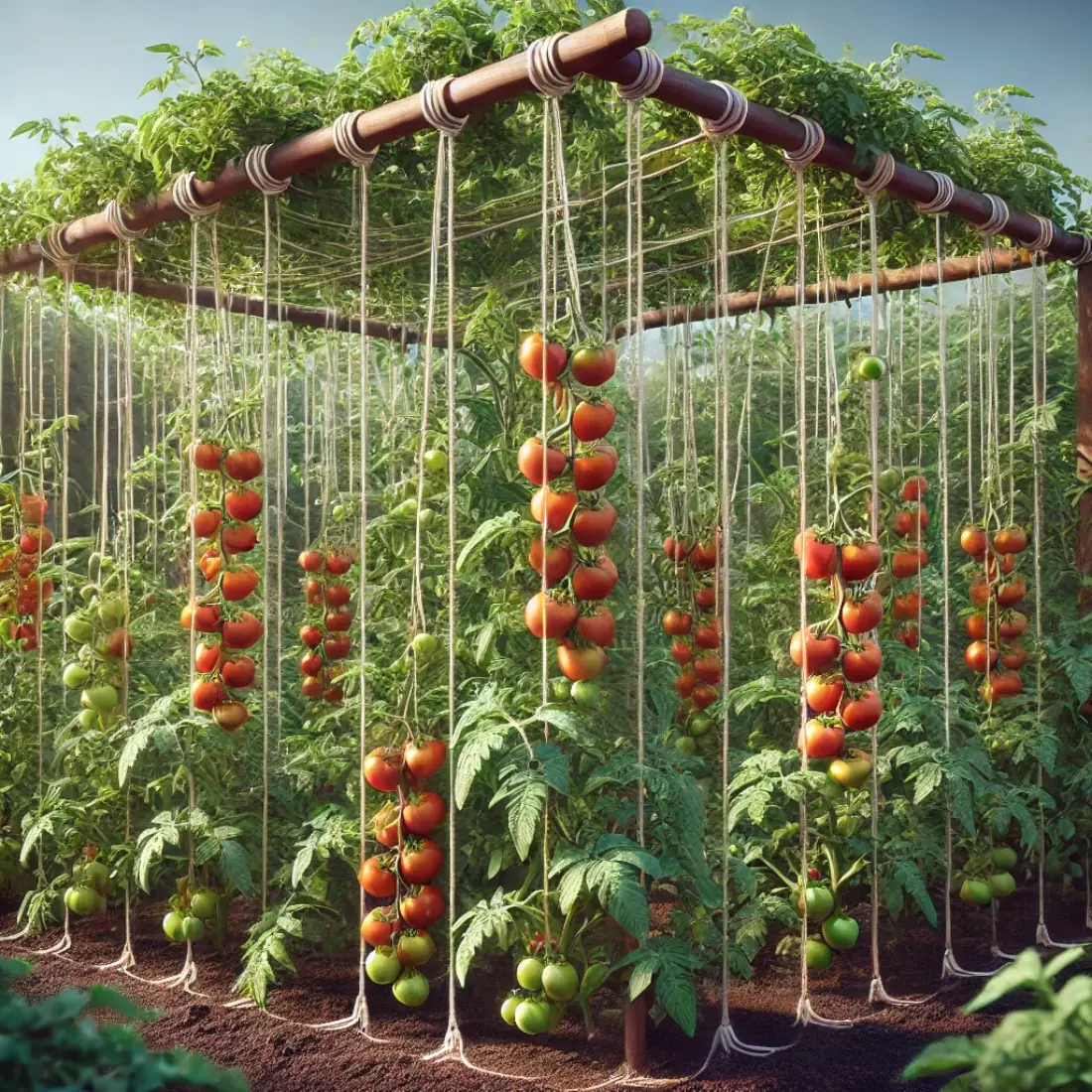
A string trellis is ideal for indeterminate tomato varieties, which grow continuously throughout the season. This method involves suspending a string or twine from a horizontal support above the plants, with the string hanging down to the base of each plant. As the tomato plant grows, it is carefully wound around the string, providing vertical support. String trellises are space-efficient and perfect for high-yield gardens.
Panel Trellis
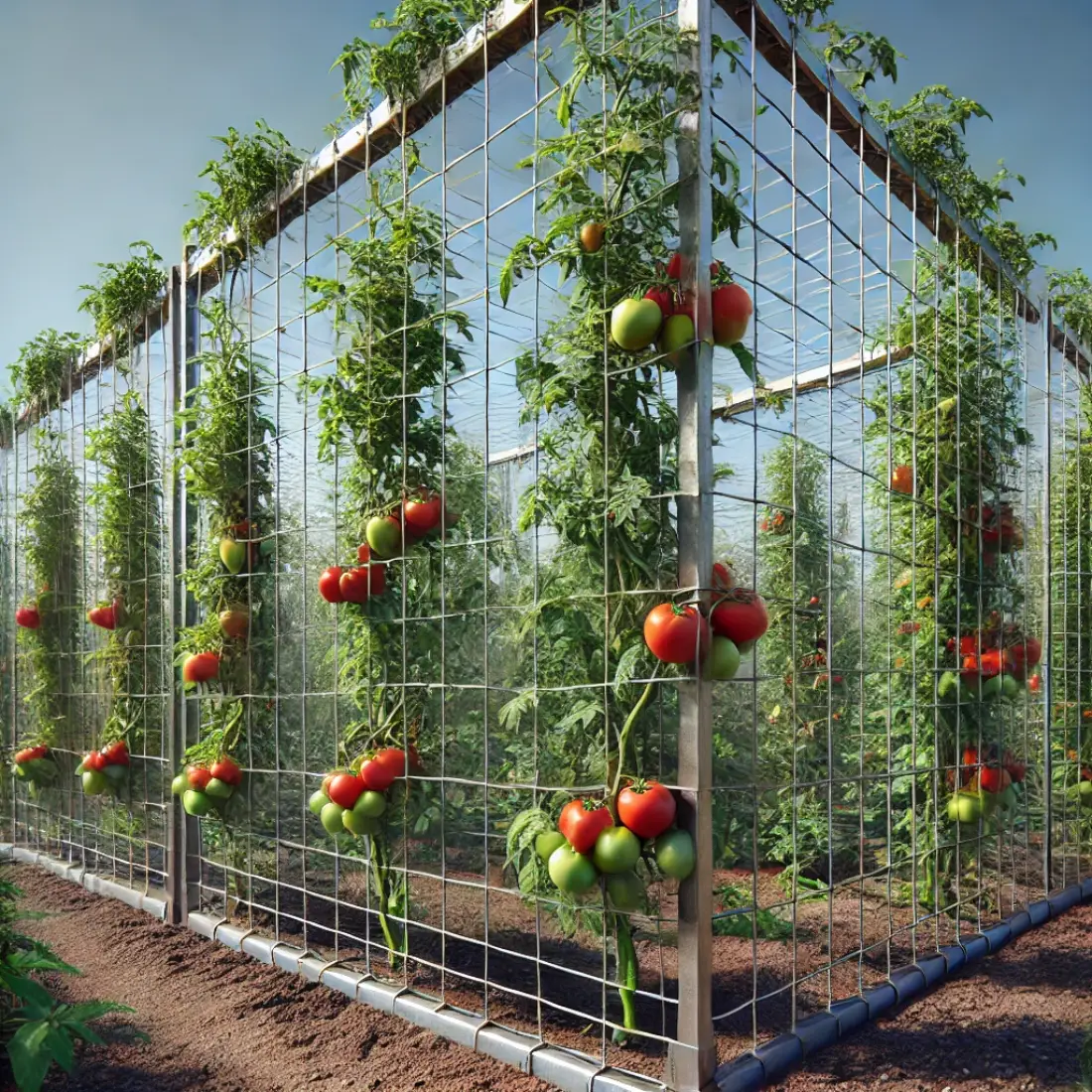
A panel trellis offers a versatile and durable solution for supporting tomato plants. Made from welded wire or metal mesh panels, these trellises are strong enough to support multiple plants and heavy fruit loads. They can be installed in various configurations, such as flat against a fence or in a V-shape for better access and air circulation. Panel trellises are a great choice for gardeners looking for a robust and long-lasting solution.
Step-by-Step Guide to Building a Basic Tomato Trellis
Building your own tomato trellis can be a rewarding and cost-effective way to support your tomato plants. Follow this step-by-step guide to create a sturdy and reliable trellis.
Planning Your Trellis
Determine the Size: Measure the area where you plan to install the trellis. Ensure it fits your garden space and allows for adequate plant spacing.
Choose Materials: Select sturdy materials like wooden stakes or metal pipes for the frame and strong twine or wire for support.
Materials Needed
- 4 wooden stakes (6-8 feet tall)
- Garden twine or wire
- Hammer or mallet
- Measuring tape
- Zip ties or garden clips
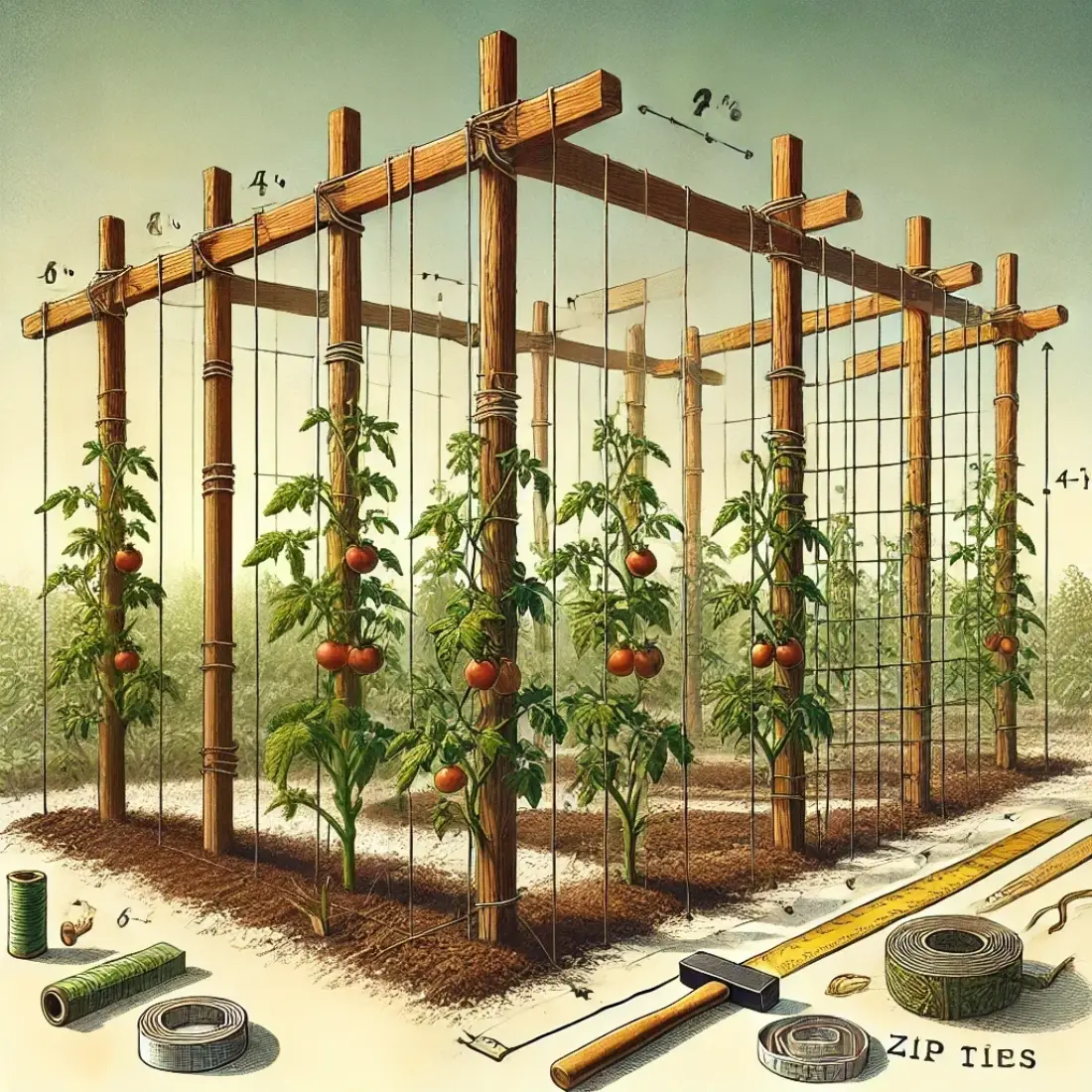
Building the Frame
Position the Stakes:
- Drive the wooden stakes into the ground at each end of the tomato row, spacing them 4-6 feet apart. Use a hammer or mallet to secure them firmly into the soil, about 1-2 feet deep.
- Ensure the stakes are vertically aligned and stable.
Attach Horizontal Supports:
- Run the twine or wire horizontally between the stakes at various heights, starting 1 foot from the ground and adding more rows every 1-2 feet. Secure the twine or wire tightly at each stake using zip ties or knots.
- Ensure the horizontal supports are taut to provide adequate support for the tomato plants.
Add Vertical Supports:
- Attach additional vertical twine or wire from the top horizontal support to the base of each tomato plant. These vertical supports will help guide the plant as it grows and keep it upright.
Installing the Trellis in Your Garden
Position the Trellis:
- Place the trellis in the garden, ensuring it is centered over the tomato plants.
- Ensure the stakes are firmly embedded in the soil to withstand wind and plant weight.
Secure the Plants:
- As the tomato plants grow, gently tie them to the vertical supports using soft garden ties or twine. Be careful not to damage the stems.
- Adjust the ties as the plants grow taller to provide continuous support.
Maintenance and Tips
Regular Inspection:
- Check the trellis regularly to ensure it remains stable and the supports are secure.
- Tighten any loose twine or wire and re-tie plants as needed.
End of Season Care:
- At the end of the growing season, remove the twine or wire and store the stakes in a dry place to prolong their lifespan.
Common Problems and Solutions
Building and maintaining a tomato trellis can sometimes present challenges. Here are some common problems and their solutions:
Sagging Trellis
- Problem: Over time, the weight of the tomato plants and fruit can cause the trellis to sag.
- Solution: Reinforce the trellis by adding extra stakes or crossbars. Use stronger materials like metal stakes or thicker wooden posts. Regularly tighten the twine or wire supports to maintain tension.
Pest Issues
- Problem: Pests such as aphids, hornworms, and whiteflies can infest trellised tomatoes.
- Solution: Monitor your plants regularly for signs of pests. Use natural remedies like neem oil or insecticidal soap. Encourage beneficial insects like ladybugs and lacewings to control pest populations.
Plant Damage
- Problem: Improper handling can damage the tomato plants when tying them to the trellis.
- Solution: Use soft garden ties or twine and tie plants loosely to avoid constricting the stems. Handle plants gently, especially when adjusting ties or during high winds.
Inadequate Support
- Problem: The trellis may not provide enough support for heavy fruit-bearing branches.
- Solution: Add additional horizontal and vertical supports as needed. Use sturdy materials that can bear the weight of the fruit. Prune the plants to manage their size and distribute weight evenly.
Weather Damage
- Problem: Strong winds or heavy rain can damage the trellis and plants.
- Solution: Secure the trellis firmly in the ground and use additional stakes for stability. Consider using windbreaks or positioning the trellis in a sheltered area of your garden.
FAQs about Tomato Trellis
What is the best height for a tomato trellis?
The ideal height for a tomato trellis is generally between 5 to 6 feet. This height supports the growth of indeterminate tomato varieties, which can grow quite tall throughout the season.
Can I use the same trellis for other plants?
Yes, many trellises are versatile and can be used for other climbing plants such as cucumbers, beans, and peas. Ensure the trellis is sturdy enough to support the weight of different plants.
How often should I check my trellis for maintenance?
Regular maintenance is key. Inspect your tomato trellis every few weeks to ensure all ties are secure, the structure is stable, and there are no signs of damage or wear.
What materials are best for building a tomato trellis?
Wooden stakes, metal pipes, and strong twine or wire are commonly used materials. Metal is more durable and long-lasting, while wood is easier to work with and readily available.
How do I tie tomato plants to the trellis without damaging them?
Use soft garden ties or twine and tie the plants loosely to avoid constricting the stems. Ensure there is enough room for the plant to grow without being damaged by the ties.
Can I move my tomato trellis once it’s installed?
It’s possible, but it can be challenging, especially if the plants are already established. It’s best to plan and install the trellis in a permanent location to avoid disturbing the plants.
How do I prevent my tomato trellis from sagging?
Reinforce the trellis with extra stakes or crossbars, and regularly tighten the twine or wire. Using stronger materials for the frame can also help prevent sagging.
What type of trellis is best for indeterminate tomato varieties?
String trellises and panel trellises are ideal for indeterminate varieties. They provide the vertical support needed for the continuous growth of these types of tomatoes.
How can I protect my tomato plants on the trellis from pests?
Monitor your plants regularly and use natural remedies like neem oil or insecticidal soap. Encouraging beneficial insects like ladybugs can also help control pest populations.
Do I need to prune my tomato plants when using a trellis?
Pruning can be beneficial, especially for indeterminate varieties. It helps manage plant size, improves air circulation, and ensures that the trellis can support the weight of the plant and its fruit.

